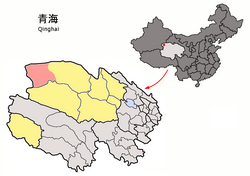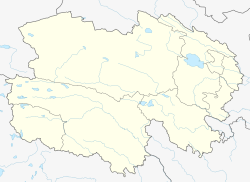|
Mangnai
Mangnai, also known as Mang'ai, is a county-level city in the northwest of Qinghai Province, China, bordering Xinjiang to the north and west. It is under the administration of Haixi Mongol and Tibetan Autonomous Prefecture. It is one of the most remote cities in China, the closest other city, Ruoqiang, is located 350 kilometres (220 mi) away.[3] In 2020 it had a population of 18856.[4] The name Mangnai is based on the Mongolian word for 'forehead'.[5] It was formed in 2018 when the Mangnai and Lenghu administrative zones merged to establish the county-level city of Mangnai.[5] EconomyMangnai had a large asbestos mine, it was the largest in China, it also holds around half of China's serpentine reserves.[6][7][8] It also produces oil, natural gas, celestite, and sodium sulfate.[5] Administrative divisionsMangnai is divided into 3 towns. The administrative center is the Huatugou Town.[5]
Demographics17 different ethnic groups live in the city, including the Han Chinese, Mongols, Tibetans, the Hui, Salars, Monguors, Manchus, Dongxiangs, and Uighurs.[4] Climate
TourismThe main touristic sites in Mangnai are:[5]
In 2019, a camp meant to simulate conditions on the planet Mars opened in the town of Lenghu, which is primarily geared towards tourists.[11] TransportMangnai is located strategically on one of the main transport corridors between Gansu and Xinjiang. The Haixi Huatugou Airport serves Mangnai and the city is served by the Golmud–Korla railway and is located along China National Highway 315.[3] Notes
References
|
||||||||||||||||||||||||||||||||||||||||||||||||||||||||||||||||||||||||||||||||||||||||||||||||||||||||||||||||||||||||||||||||||||||||||||||||||||||||||||||||||||||||||||||||||||||||||||||||||||||||||||||||||||||||||||||||||||||||||||||||||||||||||||||||||||||||||||||||||||||||


